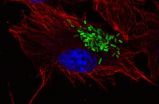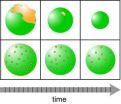(Press-News.org) Ethanol, a component of biofuel made from plants such as corn, is blended with gas in many parts of the country, but has significantly different fluid properties than pure gasoline. A group of researchers from the University of Michigan wondered how ethanol-based fuels would spread in the event of a large aquatic spill. They found that ethanol-based liquids mix actively with water, very different from how pure gasoline interacts with water and potentially more dangerous to aquatic life. The scientists will present their results, which could impact the response guidelines for ethanol fuel-based spills, at the American Physical Society's (APS) Division of Fluid Dynamics (DFD) meeting, held Nov. 18 – 20, in San Diego, Calif.
"Ethanol/gasoline blends are often presented as more environmentally benign than pure gasoline, but there is, in fact, little scientific research into the effects these blends could have on the health of surface waters," says Avery Demond, an associate professor and director of the Environmental and Water Resources Engineering program at the University of Michigan, and one of the researchers who is working on the project. Some reports written for the State of California include methods for calculating the spread of ethanol into water based on a passive diffusion/dispersion process, notes Demond, but the method was not based on strong scientific evidence of how the two fluids interact.
The Michigan researchers were motivated to fill some of the knowledge gaps. They experimented by filling a tank with water, covering the water with a plate, and pouring ethanol mixtures on top. The plate was then pulled away and the researchers recorded videos of the two fluids as they began to mix. The videos showed flow patterns called convection cells forming at the interface of the ethanol mixture and water. The mixing of the two fluids produced heat that changed the density and viscosity of the fluid, giving rise to circulation currents. In contrast, pure gasoline is essentially insoluble in water and primarily remains on the surface where it vaporizes into the air.
"The mixing behavior [of ethanol-based fuel mixtures and water], from my perspective, is very unusual," says Demond. "I've never seen anything quite like it and it certainly is not passive the way that modeling guidelines suggest." Aline Cotel, also an associate professor at the University of Michigan and another member of the research team, will present videos of the unusual mixing patterns at the conference.
As a next step, the researchers would like to study how different ethanol mixtures vaporize, helping them to determine how much of a spill would end up mixed into the water and how much would volatilize into the air. Although ethanol is biodegradable, in high concentrations it can be toxic to fish and other aquatic life. The ethanol in ethanol/gasoline blends might also transport some of the carcinogenic components of gasoline into the water during the mixing process.
"We can't make statements about the environmental impact of ethanol before we've more fully investigated its potential effects on surface water quality in the event of a spill," note the researchers.
Ultimately, they hope their work will help answer outstanding questions about how ethanol mixes with water, giving scientists and policy makers a firmer grasp of the potential risks of ethanol-based biofuels.
###
Presentation: "Characterization of Mixing Between Water and Biofuels," is at 9:31 a.m. on Tuesday, Nov. 20, in room 23A.
Abstract: http://meeting.aps.org/Meeting/DFD12/Event/178765
MORE MEETING INFORMATION
The 65th Annual Meeting of the American Physical Society (APS) Division of Fluid Dynamics will take place from November 18-20, 2012, in San Diego, Calif. It will bring together researchers from across the globe to address some of the most important questions in modern astronomy, engineering, alternative energy, biology, and medicine. All meeting information, including directions to the Convention Center, is at: http://apsdfd2012.ucsd.edu/
USEFUL LINKS
Main Meeting Web Site: http://apsdfd2012.ucsd.edu/
Searchable Abstracts: http://meeting.aps.org/Meeting/DFD12/APS_epitome
Directions and Maps: http://apsdfd2012.ucsd.edu/?page=Venue_and_Maps
PRESS REGISTRATION
Credentialed full-time journalists and professional freelance journalists working on assignment for major publications or media outlets are invited to attend the conference free of charge. If you are a reporter and would like to attend, please contact Charles Blue (dfdmedia@aps.org, 301-209-3091).
SUPPORT DESK FOR REPORTERS
A media-support desk will be available. Press announcements and other news will be available in the Virtual Press Room (see below).
VIRTUAL PRESS ROOM
The APS Division of Fluid Dynamics Virtual Press Room will be launched in mid-November and will feature news releases, graphics, videos, and other information to aid in covering the meeting on site and remotely. See: http://www.aps.org/units/dfd/pressroom/index.cfm
GALLERY OF FLUID MOTION
Every year, the APS Division of Fluid Dynamics hosts posters and videos that show evocative images and graphics from either computational or experimental studies of flow phenomena. The outstanding entries are selected for their artistic content, originality, and ability to convey information. They will be honored during the meeting, placed on display at the 2013 APS March Meeting, and appear in the annual Gallery of Fluid Motion article in the American Institute of Physics' journal, Physics of Fluids.
Selected entries from the Gallery of Fluid Motion will be hosted as part of the Fluid Dynamics Virtual Press Room. In mid-November, when the Virtual Press Room is launched, another announcement will be sent out.
This release was prepared by the American Institute of Physics (AIP) on behalf of the American Physical Society's (APS) Division of Fluid Dynamics (DFD).
ABOUT THE APS DIVISION OF FLUID DYNAMICS
The Division of Fluid Dynamics of the American Physical Society (APS) exists for the advancement and diffusion of knowledge of the Physics of Fluids with special emphasis on the dynamical theories of the liquid, plastic and gaseous states of matter under all conditions of temperature and pressure. See: http://www.aps.org/units/dfd/
Mixing processes could increase the impact of biofuel spills on aquatic environments
2012-11-16
ELSE PRESS RELEASES FROM THIS DATE:
Creating a coating of water-repellent microscopic particles to keep ice off airplanes
2012-11-16
To help planes fly safely through cold, wet, and icy conditions, a team of Japanese scientists has developed a new super water-repellent surface that can prevent ice from forming in these harsh atmospheric conditions. Unlike current inflight anti-icing techniques, the researchers envision applying this new anti-icing method to an entire aircraft like a coat of paint.
As airplanes fly through clouds of super-cooled water droplets, areas around the nose, the leading edges of the wings, and the engine cones experience low airflow, says Hirotaka Sakaue, a researcher in the ...
Visualizing floating cereal patterns to understand nanotechnology processes
2012-11-16
Small floating objects change the dynamics of the surface they are on. This is an effect every serious student of breakfast has seen as rafts of floating cereal o's arrange and rearrange themselves into patterns on the milk. Now scientists have suggested that this process may offer insight into nanoscale engineering processes.
"Small objects floating on the fluid-air interface deform the surface and attract each other through capillary interactions, a phenomenon dubbed `The Cheerios Effect,''' explains student Khoi Nguyen. "Interesting motions occur here caused by attractive ...
Study finds how bacteria inactivate immune defenses
2012-11-16
A new study by researchers at Imperial College London has identified a way in which Salmonella bacteria, which cause gastroenteritis and typhoid fever, counteract the defence mechanisms of human cells.
One way in which our cells fight off infections is by engulfing the smaller bacterial cells and then attacking them with toxic enzymes contained in small packets called lysosomes.
Published today (Thursday) in Science, the study has shown that Salmonella protects itself from this attack by depleting the supply of toxic enzymes.
Lysosomes constantly need to be replenished ...
Arthritis study reveals why gender bias is all in the genes
2012-11-16
Researchers have pieced together new genetic clues to the arthritis puzzle in a study that brings potential treatments closer to reality and could also provide insights into why more women than men succumb to the disabling condition.
Rheumatoid arthritis – which affects more than 400,000 people in the UK and about 1% of the world's population – is a complicated disease: lifestyle and environmental factors, such as smoking, diet, pregnancy and infection are thought to play a role, but it is also known that a person's genetic makeup influences their susceptibility to the ...
Uncommon features of Einstein's brain might explain his remarkable cognitive abilities
2012-11-16
TALLAHASSEE, Fla. Portions of Albert Einstein's brain have been found to be unlike those of most people and could be related to his extraordinary cognitive abilities, according to a new study led by Florida State University evolutionary anthropologist Dean Falk.
Falk, along with colleagues Frederick E. Lepore of the Robert Wood Johnson Medical School and Adrianne Noe, director of the National Museum of Health and Medicine, describe for the first time the entire cerebral cortex of Einstein's brain from an examination of 14 recently discovered photographs. The researchers ...
Study shows large-scale genomic testing feasible, impacts therapy
2012-11-16
DENVER – Targeted cancer therapy has been transforming the care of patients with non-small-cell lung cancer (NSCLC). It is now standard practice for tumor specimens from NSCLC patients to be examined for EGFR mutations and ALK rearrangements to identify patients for therapy with EGFR and ALK inhibitors, respectively. Now, researchers say large-scale genomic testing is feasible within the clinical workflow, impacting therapeutic decisions. The study is published in the December 2012 issue of the International Association for the Study of Lung Cancer's (IASLC) Journal of ...
Study shows bone metastases treatment can improve overall survival
2012-11-16
DENVER – It is common for patients initially diagnosed with lung cancer to have the cancer spread to sites like the liver, brain and bone. One of the most frequent sites of metastases is the bone, with an estimated 30 to 40 percent of patients with non-small-cell lung cancer (NSCLC) developing bone loss. A study published in the December 2012 issue of the International Association for the Study of Lung Cancer's (IASLC) Journal of Thoracic Oncology, shows that the bone metastases drug denosumab was associated with improved overall survival compared with zoledonic acid (ZA). ...
LLNL scientists assist in building detector to search for elusive dark matter material
2012-11-16
Lawrence Livermore National Laboratory researchers are making key contributions to a physics experiment that will look for one of nature's most elusive particles, "dark matter," using a tank nearly a mile underground beneath the Black Hills of South Dakota.
The Large Underground Xenon (LUX) experiment located at the Sanford Underground Research Facility in Lead, S.D. is the most sensitive detector of its kind to look for dark matter. Thought to comprise more than 80 percent of the mass of the universe, scientists believe dark matter could hold the key to answering some ...
Study: Cellphone bans associated with fewer urban accidents
2012-11-16
CHAMPAIGN, Ill. — Cellphones and driving go together like knives and juggling. But when cellphone use is banned, are drivers any safer?
It depends on where you're driving, a study by University of Illinois researchers says.
The study found that, long-term, enacting a cellphone ban was associated with a relative decrease in the accident rate in urban areas. However, in very rural areas, cellphone bans were associated with higher accident rates than would otherwise be expected.
"The main idea is to use the eye test when it comes to cellphone use," says study leader ...
Airborne particles smuggle pollutants to far reaches of globe
2012-11-16
RICHLAND, Wash. -- Pollution from fossil fuel burning and forest fires reaches all the way to the Arctic, even though it should decay long before it travels that far. Now, lab research can explain how pollution makes its lofty journey: rather than ride on the surface of airborne particles, pollutants snuggle inside, protected from the elements on the way. The results will help scientists improve atmospheric air-quality and pollution transport models.
The results also show that the particles that envelop pollutants also benefit from this arrangement. The new study in Environmental ...


